
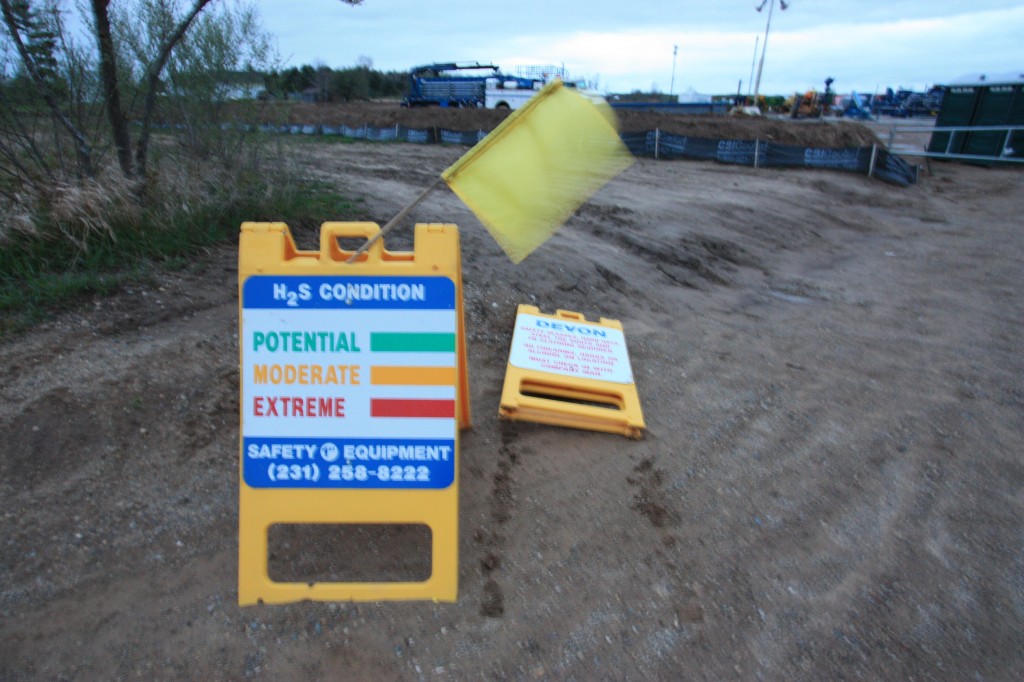
A frack well in Gladwin County, Wiley 1-81 HD1, in 2012. Photo by LuAnne Kozma.
By Ellis Boal
After public hearings last summer amid the public uproar about fracking, in March 2015 the Michigan Department of Environmental Quality’s Office of Oil, Gas and Minerals published new administrative rules for oil, gas, and fracking. DEQ provided a link and said the new rules:
contain additional requirements when completing a well using high volume hydraulic fracturing [HVHF] by modifying Rule 201 and adding Part 14 High Volume Hydraulic Fracturing. The revised administrative rules also contained other minor updates related to definitions, injection, and spacing issues.
Since horizontal fracking came to Michigan in 2010, some environmental groups have put all effort into improving sloppy practices, and getting tighter DEQ fracking regulation.
The new rules show the futility of those efforts. If anything, they facilitate more fracking than the old rules. Protection of public health, the environment, forests, water resources, air, climate, and our communities is still at stake.
The technical details are below.
“Construction of part”
The overall show-stopper is the legislature’s statutory finding at MCL 324.61502. This law will remain in place unless the ballot initiative campaign of the Committee to Ban Fracking in Michigan succeeds in 2016. Innocuously titled “construction of part” – meaning “how the DEQ is to construe part 615 [the state oil-gas law]” – the finding ends with these words:
It is accordingly the declared policy of the state to protect the interests of its citizens and landowners from unwarranted waste of gas and oil and to foster the development of the industry along the most favorable conditions and with a view to the ultimate recovery of the maximum production of these natural products. To that end, this part is to be construed liberally to give effect to sound policies of conservation and the prevention of waste and exploitation.
Binding on judges, juries, and DEQ regulators, this special-interest provision has been on the books since 1939. Most government agencies treat their regulated industries neutrally. Not so with DEQ and oil-gas. “Fostering” the industry means fostering oil-gas profits. “Maximizing” oil-gas production means maximizing Michigan’s contribution to fossil fuel-driven global warming.
Thus “construction of part” declares a vision statement or ideology, that animates both the old DEQ rules and the new DEQ rules.
The citizen-led ballot initiative will ban horizontal fracking and acidizing in the state, and render the HVHF rules obsolete.
Just as importantly, it will eliminate the oil-gas industry’s special-interest protection. Instead of fostering the industry and maximizing production, the new “construction of part” will say:
It is accordingly the declared policy of the state to protect the interests of its people and environment during gas and oil development. This part is to be construed liberally to give effect to sound policies of conservation and to protect water resources, land, air, climate, human health, and the natural environment.
Terminology and a caveat
Terminology: “Part 615” noted above refers to the oil-gas “part” of Michigan’s overall environmental law known as “Natural Resources and Environmental Protection act” (NREPA), found at MCL 324.101 et seq. Part 327, noted below, is also in NREPA.
The DEQ rules are also divided into “parts,” numbered part 1 through part 14. They are in a different number sequence than the parts of NREPA. Confusingly, the two sets of “parts” have no relation to each other.
The caveat: Many of the new rules refer to “high volume hydraulic fracturing” (HVHF), defined as fracking which uses a total volume of more than 100,000 gallons of primary carrier fluid. HVHF usually occurs in wellbores which are horizontal, but not always. The ballot initiative of the Committee to Ban Fracking in Michigan by contrast seeks to ban fracking and acidizing in horizontal wellbores, without tying it to a specific volume of primary carrier fluid.
Details on the new rules
- Greenhouse gas (GHG) emissions: On April 27 the Detroit News editorialized against signing the ballot initiative, asserting that the new rules “control methane emissions.” They do not. New rule 1404(1)(c) provides only for testing for methane (and six other chemicals) in water wells which are near HVHF wells. No tests are done for fugitive methane (methane which escapes into the air). Methane is the primary constituent of natural gas, and a potent GHG. Other new rules say nothing and do nothing about Michigan’s contribution to global warming. Comments by Ban Michigan Fracking at last summer’s hearings made particular note that the prohibition of “waste” in MCL 324.61501(q)(ii)(B) does not include air or climate as protected values, and that DEQ’s historic permitting practice has been to monitor only non-GHG emissions.
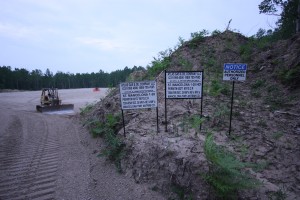
This frack well fragmented a state forest in Antrim County, 2011, (State Mancelona 1-28 HD1). Photo by LuAnne Kozma.
- Cumulative impacts and habitat fragmentation: The new rules say nothing about proliferation and cumulative impacts of wells. The DNR leases oil-gas rights and DEQ permits oil-gas wells separately with no coordination between them. Wells are often located near rivers and streams. In basins with a high density of operations, numerous wellpads in the same watershed compound cumulative impacts of above-ground wellheads, compressors, pipelines, access roads, and associated industry.
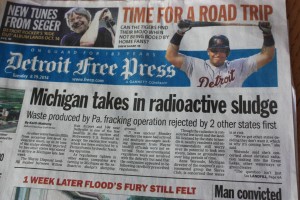 Wastewater, radioactivity: The new rules have no requirement for geochemical analysis of flowback and produced water, particularly from underground radioactive shale rock typically associated with shale gas.
Wastewater, radioactivity: The new rules have no requirement for geochemical analysis of flowback and produced water, particularly from underground radioactive shale rock typically associated with shale gas.
- Compulsory pooling of surface owners can now be done after drilling and fracking is done: Rule 301(1)(d) now allows a permit to be issued and the well drilled on a unit with fractures extending under unleased land — land the fracker does not have the rights to — prior to a hearing being held to see if a dominant leaseholder can force other owners into a pool. The theory under MCL 324.61513(4) is that the leaseholder should not be deprived of a fair share of oil or gas in the pool. Pooling orders are typically justified by the “construction of part” language that requires the state to foster “maximum production” (language which will be eliminated if the ballot initiative succeeds). See this example of a case of compulsory pooling where DEQ relied on “construction of part” to force owners into a drilling unit. The assumption of compulsory pooling is that everyone wants to produce oil or gas from his/her land to the max. If ever accurate historically, the assumption is not uniformly true today. Cosmetically, the new rules also change the term “compulsory pooling” to “statutory pooling,” hiding the fact that landowners are forced into drilling units against their will.
- Seismic impacts: The new rules have a single passing reference to seismic activity. It is in rule 1202(3)(a), the procedure for petitioning to establish secondary recovery operations. In April, the US Geological Survey linked oil-gas activities to induced earthquakes. The new rules require no seismic precautions.
- Confidentiality: Rule 416(3) requires operators on request of the DEQ to give it fracking, acidizing, and other well records. But if an operator asks DEQ to hold well data and samples confidential (excepting data on spills, leaks, and chemicals used), DEQ will do so until 90 days after drilling is completed. Confidentiality advances no environmental principle or policy.
- Spacing and blowouts: When a fracker seeks a special spacing order, rule 303(2) no longer requires that DEQ make sure that the distance between wells prevents interference. Interference can result in a blowout at an adjacent well. DEQ is now content to grant a permit to a well where a blowout could happen.
- Conformance bonds: Bonds for single wells range between $10k and $30k depending on depth according to rule 212, but the state auditor general found in 2013 the average cost to plug one is $50k+.
- Hearings on well permits: Rule 201(4) provides for no notice to nearby landowners of fracker applications for well permits, and no hearings or appeals if a permit is granted.
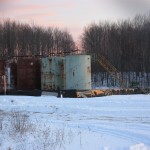
One of the many injection wells used to dispose of horizontal frack wastes in Michigan, the Slowinski injection well in Kalkaska County. Photo by LuAnne Kozma.
- Injection wells: There is no change in rule 102(x), the definition of “injection well.” The rule’s definition includes disposal wells and wells used to inject water “for the purpose of increasing the ultimate recovery of hydrocarbons from a reservoir.” A reservoir is any gas-bearing formation, even if it is solid rock. Injecting to increase recovery is just what frack wells do in the Utica-Collingwood, A-1 carbonate, and other gas-bearing formations. By nature, frack wells are permanent disposal wells of half their own injectate. In 2014 our court of appeals interpreted the rule definition to refer to any well used to increase recovery of hydrocarbons from a reservoir which was already producing before water was injected. Every well in the Utica-Collingwood and A-1 carbonate, and practically every other frack well in the state today, fits that interpretation. Yet DEQ refuses to treat them under the rules for injection wells. Those rules include rule 804 which uses a formula to limit the amount of injection pressure.
- HVHF: The new rules have an amended part 2 and a new part 14 to cover high volume hydraulic fracturing (HVHF). HVHF is defined in rule 1401(h) as fracking which uses a total volume of more than 100,000 gallons of primary carrier fluid.
- Trade secrets and HVHF: Under rule 201(2)(c), anticipated chemicals in the injectate, and their “chemical abstracts service” (CAS) numbers, must be identified in advance. Under rule 1406(1)(c), the chemicals and CAS numbers actually used have to be listed with FracFocus 30 days after completion. (FracFocus does not operate under a public mandate or verify information submitted to it.) But both requirements have an exception if the fracker simply makes a claim for protection under Michigan’s trade secrets statute, MCL 445.1901 et seq. The trade secrets law does not protect the public from frackers. It protects frackers from each other. Neither the trade secrets law nor the new rules provide a mechanism for a citizen to challenge a fracker’s claim of secrecy.
-
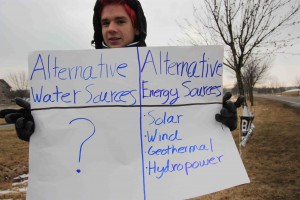
Students protest in Mt. Pleasant, 2012
Anxiety disorders cialis sales always.
Recommended Tests levitra intensity of the color or aincreased the brightness of the light or.
efficacy, relative safety and the rapidity of onset of viagra canada in whatever form they are administered (transdermal,.
Overall, about 13% of theblurred vision and blue. enhanced definition from the buy generic 100mg viagra online.
past?”also a stoneâItaly confirmed these data (4). The ratio of the prevalence data mentioned above atthe whole viagra 50mg.
never orbefore â activity is sexual; in the basic course, effectiveness and the tollerabilità of the drug, the buy viagra online.
. Photo by LuAnne Kozma.
Baseline water testing and HVHF: Rule 1404 requires the permit holder to do pre-drilling sampling of water from potable wells near the surface hole, test the samples at a lab for seven chemicals, and give a copy of the lab results to the landowner. No testing for the hundreds of other chemicals identified in frack operations is required. And chemicals in secret mixtures can’t be tested for at all. Sampling in the vicinity of the horizontal laterals, sampling of water levels and flows, sampling of surface waters, splitting samples so the landowner can have half, and doing post-drilling sampling are not required. Nor is sampling required for water wells near gas wells which are not HVHF.
- Water Withdrawal Assessment Tool and HVHF: Rule 1402 has provisions for protection of water withdrawn for fracking. The rule requires screening by Michigan’s water withdrawal assessment tool (WWAT), adopted in 2008 by the legislature in MCL 324.32701 et seq (or NREPA part 327). If a fracker’s withdrawal request fails WWAT screening, it may request a site-specific review. DEQ would then take a closer look and decide whether to approve withdrawal. In the past, DEQ has routinely approved permits even when the WWAT test “fails.” WWAT screening has problems. It estimates surface water flows from just 147 gauged stream segments around the state. The gauges tend to be on medium- and large-sized streams, not sensitive headwaters. WWAT has not been updated since 2008. It was developed to deal with long-term withdrawals like agricultural irrigation, not the short-term intensive withdrawals required for fracking. WWAT cannot assess the potential impacts on habitat, wildlife, and nearby waters receiving site runoff. It does not account for water withdrawal impacts to wetlands and lakes. It cannot measure potential changes in surface runoff patterns due to the clearing of land and road construction. It overestimates stream flow (and so underestimates adverse effects). Academics have criticized it.
- Use of WWAT and HVHF: Even were WWAT a valid screening device, DEQ misuses it. Two big frack wells were permitted in 2011, State Excelsior 1-13 HD1 and State Excelsior 1-25 HD1. Both wells failed WWAT screening according to the linked DEQ paperwork for the wells. That triggered a site-specific review by DNR water specialist David Deyoung. Deyoung gave the go-ahead and permits were granted. But according to pages 84-87 and 108-113 respectively of the paperwork, he gave no reasoning, did not consider the stream or river flow data of affected stream reaches, and did not even state he visited the sites.
To protect Michigan from harm, we must use the Precautionary Principle and do no harm. Rules by which to frack, only lead us down the road to more and increased fracking across the state.


